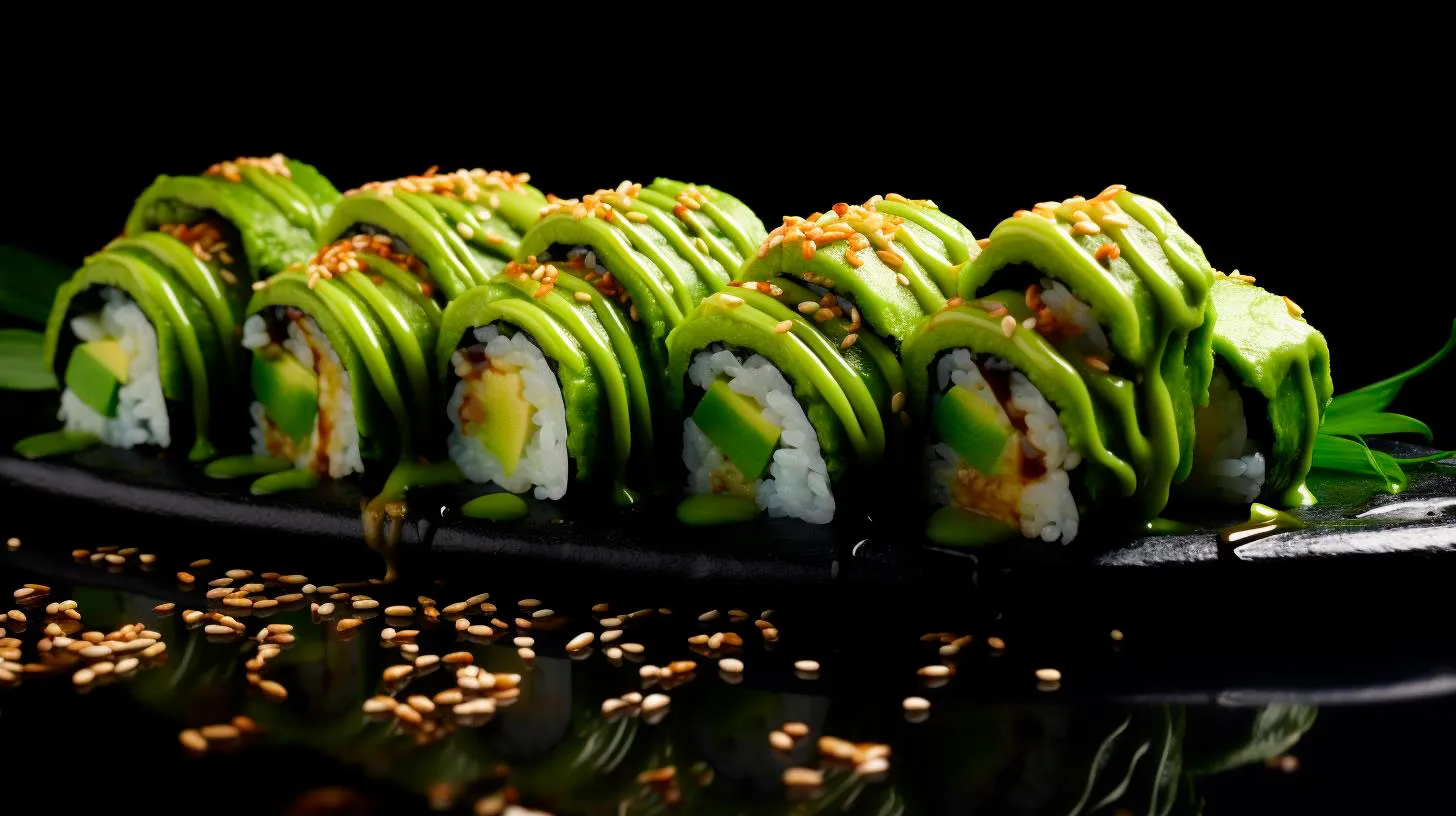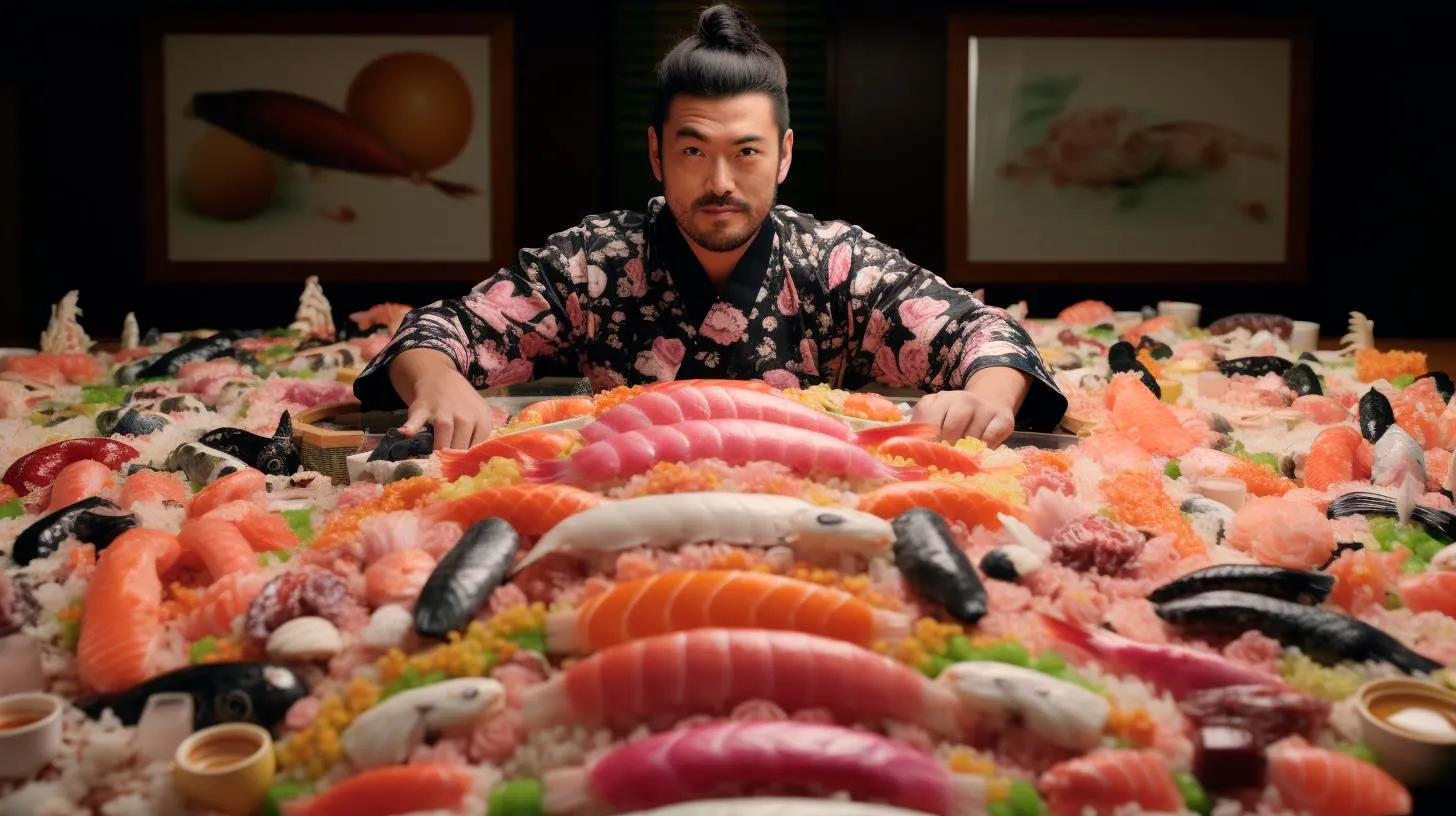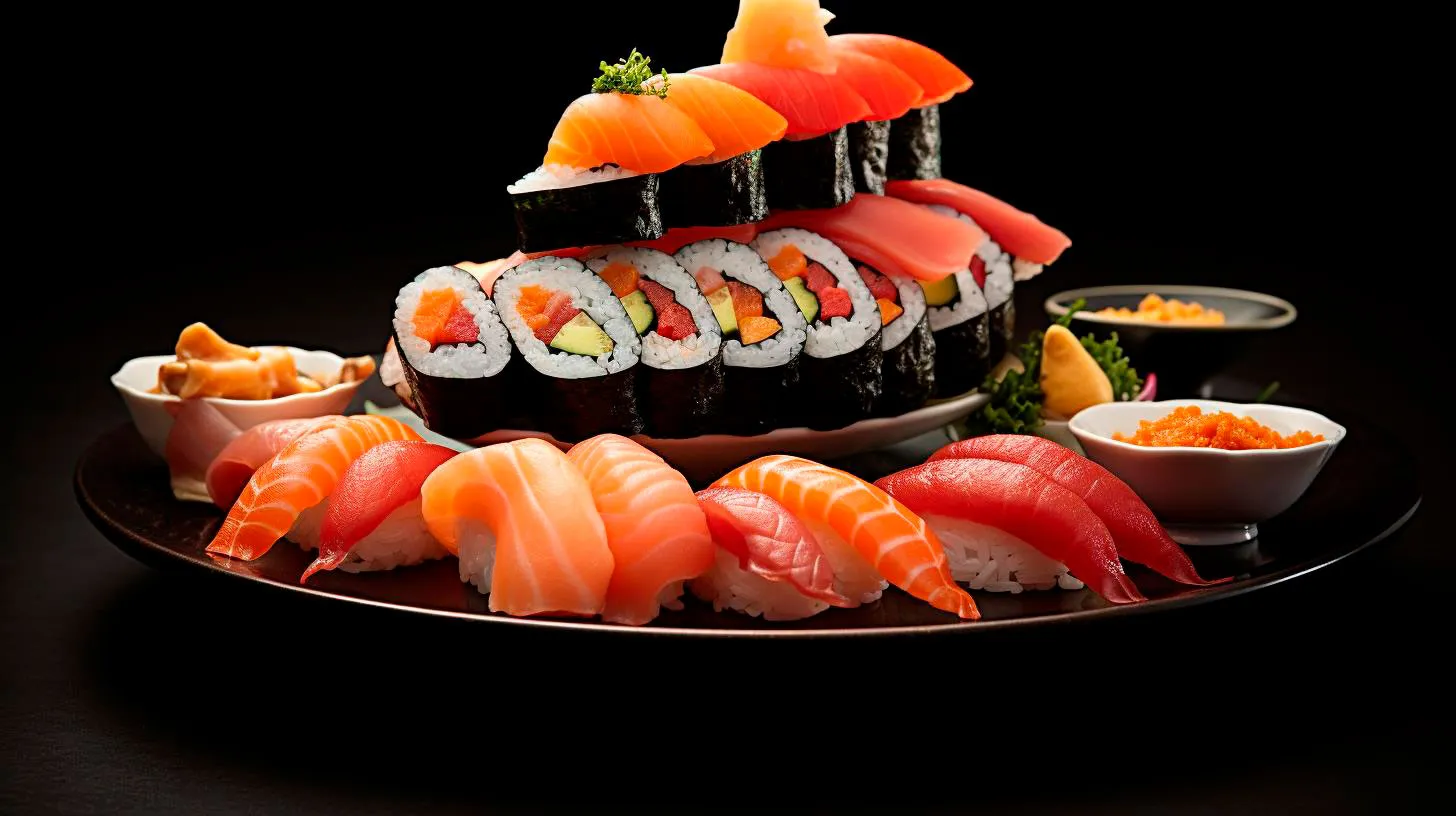Exploring Flavor Combinations: Tobiko and Masago in Sushi
In this article, we will delve into the world of sushi and explore the intriguing combination of tobiko and masago, highlighting their characteristics, advantages, and how they enhance the overall sushi experience.
The Distinctive Qualities of Tobiko and Masago
Tobiko and masago, both considered types of fish roe, differ in many aspects, such as color, size, and taste:
- Tobiko: Tobiko refers to the small, vibrant, and crunchy roe of flying fish. These tiny eggs come in various colors, including red, orange, green, and black. Each hue offers a distinct taste: red tobiko is mildly sweet, orange has a delicate smokiness, green is flavored with wasabi, and black has a savory richness. Tobiko adds a delightful pop sensation to sushi, enhancing both the aesthetics and taste.
- Masago: Masago, on the other hand, comes from the roe of capelin fish. It is smaller in size compared to tobiko and generally has a bright orange or golden hue. With a mild, slightly sweet flavor, masago provides a subtle burst of tanginess to sushi. Its texture is smooth and soft, accentuating the overall mouthfeel of the sushi roll.
The Perfect Pairing in Sushi
When it comes to sushi, combining tobiko and masago can create a harmonious flavor profile that elevates the whole experience. Their complementary characteristics contribute to a delightful explosion of flavors:
- Texture and Appearance: The contrast provided by the crunchy tobiko and the smooth masago adds visual appeal to sushi rolls. The tiny, colorful eggs create an eye-catching display, making these ingredients a popular choice for sushi chefs looking to create aesthetically pleasing presentations.
- Flavor Infusion: Tobiko’s slightly sweet and savory notes combine with masago’s subtle tanginess to produce a well-balanced taste. This fusion adds depth and complexity to the overall flavor palette of the sushi roll, making it a memorable culinary experience.
- Adding a Pop: The crunchy texture of tobiko adds a delightful pop sensation to each bite, creating an enjoyable textural contrast with the softness of the rice and other ingredients. This burst of texture provides a dynamic element to the sushi roll, making it more interesting and satisfying.
Key Takeaways for Sushi Enthusiasts
Whether you are a seasoned sushi lover or someone venturing into this culinary realm for the first time, understanding the unique qualities of tobiko and masago can enhance your dining experience:
- Experiment with Color: Different colors of tobiko offer variations in taste, allowing you to experiment and tailor your sushi experience. Try multiple colors to find your favorite flavor combination.
- Texture Matters: The texture of tobiko and masago adds an exciting element to sushi rolls, ensuring a delightful mouthfeel. Seek out sushi rolls that incorporate these ingredients for an enjoyable dining experience.
- Appealing Presentation: If you appreciate visually stunning dishes, sushi rolls with tobiko and masago are sure to please. The vibrant colors and pop of texture create a visually appealing plate that is perfect for social media-worthy food posts.
- Balance is Key: The combination of tobiko and masago contributes to a well-balanced flavor profile. Their taste, when harmoniously paired, creates an unforgettable umami experience.
In conclusion, exploring the flavor combinations of tobiko and masago in sushi reveals a whole new dimension to this beloved Japanese cuisine. The distinctive characteristics of these fish roe elements bring visual appeal, texture contrast, and a harmonious fusion of flavors to the sushi roll. So, the next time you indulge in sushi, be sure to savor the tantalizing mix of tobiko and masago for a memorable dining experience.
Elevating Sushi with Tobiko and Masago Pairings
In this article, we will explore the unique characteristics of Tobiko and Masago, their benefits, and how to incorporate them into your sushi creations.
The Uniqueness of Tobiko
Tobiko, or flying fish roe, is a popular type of fish roe renowned for its tiny, gleaming orange beads that burst with a mildly sweet and salty flavor. These delicate orbs not only add a pop of color to your sushi but also provide an enjoyable texture that complements the other ingredients perfectly.
Key advantages of Tobiko include:
- Aesthetics: The vibrant, reddish-orange hue of Tobiko creates an eye-catching contrast against the neutral tones of sushi rice and Nori seaweed.
- Flavor: The unique taste profile of Tobiko adds a delightful umami note to any sushi roll, enhancing its overall flavor.
- Texture: The delicate crunch of Tobiko creates a delightful mouthfeel, providing an enjoyable contrast to the soft rice and tender fish within the sushi roll.
Incorporating Tobiko into your sushi rolls can take your creations to new heights. Whether you’re a sushi connoisseur or just experimenting in the kitchen, Tobiko is an essential addition to any sushi party.
The Versatility of Masago
Like Tobiko, Masago is a type of fish roe that adds a burst of flavor and texture to sushi rolls. However, Masago is sourced from the Capelin fish, offering a unique flavor profile that sets it apart from Tobiko. With its smaller, darker orange beads, Masago makes an equally stunning addition to any sushi creation.
Key advantages of Masago include:
- Distinct Flavor: Masago provides a slightly less sweet and more savory taste compared to Tobiko, making it an excellent choice for those seeking a bolder flavor profile.
- Texture: The smaller beads of Masago offer a softer texture, further enhancing the overall mouthfeel of your sushi rolls.
- Cost-Effective Option: Masago tends to be more budget-friendly compared to Tobiko, allowing sushi enthusiasts to experiment with various combinations without breaking the bank.
By incorporating Masago into your sushi rolls, you can broaden your culinary horizons and create unique flavor combinations that will impress your guests.
How to Incorporate Tobiko and Masago into Sushi
Now that we have explored the qualities of Tobiko and Masago, let’s discuss some simple ways to incorporate these delightful fish roe into your sushi creations:
- Add a sprinkle of Tobiko or Masago on top of your favorite sushi rolls for an elegant and visually appealing touch.
- Mix Tobiko or Masago into the sushi rice to infuse the flavors throughout the roll.
- Combine Tobiko or Masago with spicy mayonnaise to create a delicious dipping sauce for your sushi rolls.
- Create a Tobiko or Masago-filled sushi roll for a burst of flavor with every bite.
- Use Tobiko or Masago as a garnish for sushi platters, adding a pop of color and sophistication.
By experimenting with these techniques, you can elevate your sushi-making skills and create unique combinations that cater to different palates.
Conclusion
Tobiko and Masago are culinary gems that can take your sushi experience to new heights. With their vibrant colors, distinctive flavors, and delightful textures, incorporating Tobiko and Masago into your sushi creations is a surefire way to impress your friends and family. Whether you’re a fan of traditional sushi or enjoy innovative combinations, don’t miss the opportunity to elevate your sushi game with these exquisite fish roe. So, next time you’re sushi-rolling at home, grab a jar of Tobiko or Masago and unleash your creativity!
Mastering the Perfect Balance: Tobiko, Masago, and Sushi Delights
These tiny fish eggs may be small in size, but they pack a powerful punch when it comes to enhancing the taste and aesthetic appeal of sushi. In this article, we will explore the nuances of tobiko, masago, and the art of mastering the perfect balance in sushi.
Tobiko: Bursting with Flavor and Color
Tobiko is the roe (eggs) of the flying fish, and it is widely used in sushi due to its vibrant colors and distinct taste. Native to Japan, tobiko comes in various hues such as orange, green, red, yellow, and even black. Each color brings its own unique flavor profile, allowing sushi chefs to create visually stunning and flavorful dishes.
Key takeaways about tobiko:
- Tobiko is the roe of the flying fish, known for its vibrant colors.
- The different colors of tobiko offer diverse flavor profiles.
- It adds a delightful popping texture to sushi rolls.
- Tobiko is rich in essential nutrients like omega-3 fatty acids.
Tobiko adds a delightful crunch and texture to sushi rolls, thanks to its small size and delicately thin shell. When you bite into a sushi roll that features tobiko, you’re greeted with a burst of flavor and a satisfying pop.
Aside from its aesthetic appeal and pleasing texture, tobiko is also a rich source of omega-3 fatty acids. These essential nutrients promote heart health, brain function, and overall well-being, making tobiko not only a delicious addition to sushi but also a nutritious one.
Masago: Adding Subtle Complexity to Sushi
Masago, on the other hand, is the roe of the capelin fish. This ingredient is smaller in size compared to tobiko and has a delicate and subtle flavor profile. Masago is usually orange in color and is commonly used as a garnish or in sushi rolls.
Key takeaways about masago:
- Masago is the roe of the capelin fish, adding subtle complexity to sushi.
- It provides a burst of umami flavor to sushi rolls.
- Its small size makes it a popular choice for garnishing.
- Masago is a good source of protein and important minerals.
One of the standout features of masago is its ability to enhance the umami, or savory, flavor in sushi. Its delicate taste adds layers of complexity to each roll, elevating the overall dining experience. Additionally, masago’s petite size makes it an excellent choice for garnishing sushi, adding a burst of color and texture to the dish.
Moreover, masago is a great source of protein, making it an ideal choice for those looking to incorporate more protein-rich ingredients into their diet. It also contains essential minerals like iron, providing added nutritional value to your sushi rolls.
Mastering the Balance: Tobiko, Masago, and Sushi
When it comes to mastering the art of sushi, achieving the perfect balance is crucial. Tobiko and masago play integral roles in enhancing both the flavor and visual appeal of sushi, creating a harmonious blend of taste and aesthetics.
By understanding the unique characteristics of tobiko and masago, you can experiment with different combinations and techniques to create sushi rolls that are both visually stunning and delectable. Whether you’re a sushi connoisseur or a novice, incorporating these fish roe varieties into your sushi creations will undoubtedly take your culinary skills to new heights.
So, next time you indulge in a fantastic sushi feast, pay attention to the delicate pearls of tobiko and masago, appreciating how they elevate your dining experience and contribute to the perfect balance that sushi enthusiasts seek.
Unlocking the Secrets of Tobiko and Masago in Sushi Creations
So let’s unlock the secrets of tobiko and masago and explore how they can take your sushi game to the next level!
What is Tobiko?
Tobiko, derived from the Japanese word tobi meaning “flying” and ko meaning “child,” refers to the roe (eggs) of flying fish. Native to Japan, tobiko is a delicacy that has gained immense popularity worldwide.
Tobiko Features and Advantages:
- Tobiko comes in a variety of colors, including natural orange, red, black, green, and even golden.
- Its firm outer membrane delicately encases individual fish eggs, creating a pleasurable burst of flavor with every bite.
- With its mild and slightly sweet taste, tobiko adds a touch of elegance to any sushi dish.
- Tobiko is low in calories, making it a healthier choice.
Now that we know what tobiko is, let’s move on to its counterpart, masago.
What is Masago?
Similar to tobiko, masago is another type of roe commonly used in sushi preparations. Unlike tobiko, which comes from flying fish, masago originates from capelin, a small fish found in the Arctic and North Atlantic oceans.
Masago Features and Advantages:
- With its smaller size and slightly crunchier texture compared to tobiko, masago adds a unique mouthfeel to sushi rolls.
- Typically bright orange in color, masago provides a visually appealing contrast to the other ingredients in your sushi creations.
- This ingredient offers a subtly sweet and briny taste, enhancing the overall flavor profile of the dish.
- Just like tobiko, masago is low in calories, making it a guilt-free indulgence.
Both tobiko and masago are incredibly versatile and can be used in various sushi dishes. Here are some key takeaways when incorporating these flavorful ingredients into your sushi creations:
Key Takeaways:
- Tobiko and masago add a burst of flavor, texture, and color to your sushi creations.
- They come in different colors, allowing you to experiment with vibrant presentations.
- Their mild sweetness enhances the overall taste of the sushi.
- Both tobiko and masago are low in calories, making them a healthier choice.
As sushi enthusiasts, it’s important to explore and appreciate the various ingredients that make this ancient art form so special. Tobiko and masago provide not only aesthetic appeal but also a delightful taste experience that amplifies the flavors of your favorite sushi rolls. So, the next time you indulge in sushi, don’t forget to embrace the secrets of tobiko and masago!
Until next time, happy sushi creation!



